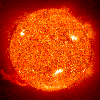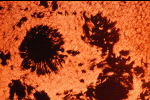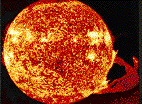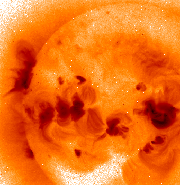 |
||
| First page | ||
 |
||
| Composition | ||
 |
||
| Activity | ||
 |
||
| The Sun as a star | ||
 |
||
| How/Why study? | ||
 |
Importance for us | |
 |
||
| Find out more | ||
 |
||
 |
||
Sunspots and the sunspot cycle
 Every now and then the sunspots are large enough to be seen with the naked eye (once more you're reminded not to look at the Sun directly). Sunspots are cooler regions in the photosphere and they appear as dark spots on the Suns surface. A sunspot can last from a couple of hours to several months, and some of them are larger than the earth. They usually appear in groups of 2 and more.
Every now and then the sunspots are large enough to be seen with the naked eye (once more you're reminded not to look at the Sun directly). Sunspots are cooler regions in the photosphere and they appear as dark spots on the Suns surface. A sunspot can last from a couple of hours to several months, and some of them are larger than the earth. They usually appear in groups of 2 and more.
It is now concluded that the number of visible sunspots varies with a period of (on average) 11.1 years, which means that there is a maximum and a minimum in visible sunspots during a cycle. Sometimes during a minimum the Sun has no visible spots at all.
Prominences

Prominences are a spectacular coronal phenomena that appear as a flame-like, red proturberance high above the Suns "surface". Some of them can remain nearly stable for hours, or even days, and can rise to thousands of kilometers above the surface. Their origin is unknown but they usually originate near regions of sunspot activity and, like spots, they seem to have a close relation to the characteristics of the local magnetic field.
Flares
Solar flares are the biggest explosions in the solar system. We say that we've seen a solar flare when we see a huge sudden increase in brightness on the Sun. Flares happen in active regions. These are parts of the Sun where the magnetic field is particularly strong and complicated and because of this there is a lot of magnetic energy associated with these regions. When the energy that has built up in the active region is released we see a flare.
Most flares are quite short really, less than hour, although the longest flare that has been seen with the Japanese Yohkoh satellite was 12 hours. Compared to flares on other stars though the Sun is a bit of a wimp - some of those flares are a thousand times more energetic than the Sun and can last up to 10 days!
Coronal mass ejections

Coronal mass ejections (CMEs) are huge bubbles of the solar atmosphere that are thrown out into interplanetary space. We see them by using instruments which occult the photosphere, in effect they are creating an artificial solar eclipse. When this is done the corona can be seen and the density variations of the corona are mapped out by radiation which is scattered off coronal electrons. The corona appears brighter where there is more coronal material along the observers line of sight. A time series of images shows the coronal mass ejection to be a moving bubble of bright material.
Never look at the Sun directly. Doing so will destroy the retinas of your eyes.
10th September 2000
Lucie Green
Sarah Amandusson
www_astro@mssl.ucl.ac.uk